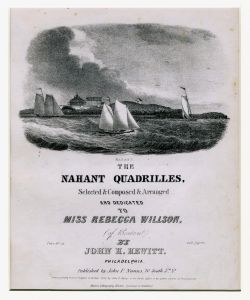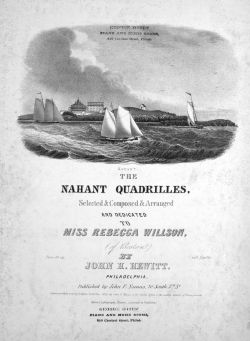loading 
Fitz Henry Lane
HISTORICAL ARCHIVE • CATALOGUE RAISONNÉ • EDUCATIONAL RESOURCE
An online project under the direction of the CAPE ANN MUSEUM
An online project under the direction of the CAPE ANN MUSEUM
Catalog entry
inv. 85
The Nahant Quadrilles
1836 Lithograph 10 x 8 in. (25.4 x 20.3 cm)
Collections:
|
Exhibition History
Boston Athenaeum, Boston, Massachusetts, Always Delightfully Cool: Summer Vacations in Northern New England, 1825-1900, May–August 2008., no. 5. [Impression: Boston Athenaeum (inv. 516)].
Published References
David Tatham. "The Pendleton-Moore Shop: Lithographic Artists in Boston, 1825-1840." Old-Time New England Vol. LXII, No. 2 (October-December 1971)., fig. 5, text p. 43, The Nahant Quadrilles.
Tatham, David. The Lure of the Striped Pig: The Illustration of Popular Music in America 1820–1870. Barre, MA: Imprint Society, 1973., no. 14. [Impression: Boston Athenaeum (inv. 516)].
Wilmerding, John. Paintings by Fitz Hugh Lane. Washington, DC: National Gallery of Art; in association with Harry N. Abrams, 1988., p.10.
Impression information
Boston Athenaeum (inv. 516)
Scratched in the stone, lower right of image: F.H. Lane
Printed lower edge of sheet: Moore's Lithography, Boston.
Boston Athenaeum, Gift of Charles E. Mason, Jr., 1976 (1976.38)
Provenance
Charles E. Mason, Jr.
Boston Athenaeum, April 1976
The Huntington Library (inv. 723)
The Huntington Library, San Marino, California. The Jay T. Last Collection.
Provenance
The Huntington Library, San Marino, California
Johns Hopkins University (inv. 759)
Lester S. Levy Collection of Sheet Music, Sheridan Libraries, Johns Hopkins University
Provenance
Johns Hopkins University, Baltimore, Maryland
Massachusetts Historical Society (inv. 418)
Massachusetts Historical Society, Boston (M1.A1 A1)
Provenance
Massachusetts Historical Society, Boston



Commentary
This lithograph was drawn on stone by Lane; it is signed in the stone within the design at the lower right, directly under the vessel on the right, at the bottom of the vignette. It was printed at Moore's.
Located seven miles northeast of Boston, Nahant is essentially two rocky islands, connected to each other and to the city of Lynn by a sandy causeway. By the 1830s, it was a well-known resort for summer visitors (mainly from Boston) and as a sea mark for yachtsmen cruising the coast. As conspicuous as its rock formations were, the hotels which occupied Nahant’s southern end offered spectacular views of sea and shore in almost any direction. Two examples figure prominently in this image.
For all its scenic offerings, Nahant did not get the sustained attention of artists until the 1880s. Robert Salmon painted two views of it in 1839; Lane’s painting of Egg Rock (off Nahant’s east shore) was his last exhibition work at the Boston Athenaeum in 1865—and his only known depiction on canvas of this location. William Bradford and Albert Van Beest were active in the Lynn/Nahant area in the 1850s, followed by occasional visiting artists in the post-Civil War decade. The 1870s saw visiting artists regularly, together with recognition of talented local residents whose output was receiving acclaim in Boston galleries. This recognition won for them the group—and style name—“The Lynn Beach Painters.” (1)
All of the works of the aforementioned artists are preceded by Lane’s lithograph, published in 1836. Nothing is known about the preliminary drawing he used – whether it was his or someone else’s—but there is little question that the vessels depicted are either original to Lane or corrected to meet his standards of accuracy. The wave patterns and cloud formations are also in keeping with his style, although there may have been some influence—or tutelage—by Salmon while he had a studio close by Pendleton’s establishment. This view shows three cruising vessels: at left, a schooner (possibly also sailed in yacht races), a small sprit-rigged ketch at center, and a sloop at right.
–Erik Ronnberg
Reference:
1. D. Roger Howlett, “The Lynn Beach Painters: Art Along the North Shore 1880-1920” (Lynn, MA: the Lynn Historical Society, 1998), pp. 12–23.